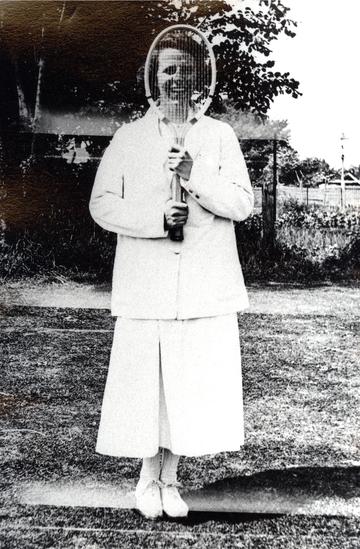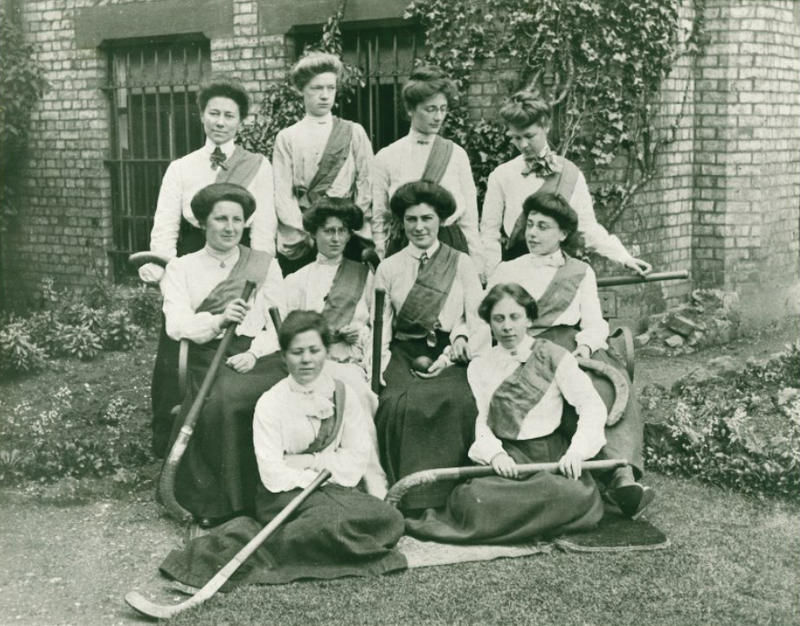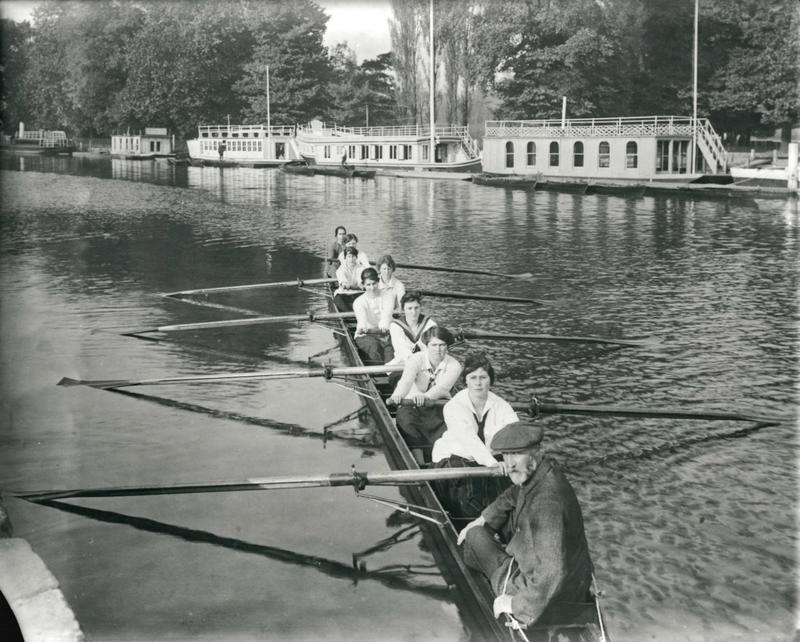Women and Sport
Lucia Qureshi

Evelyn Irons (Somerville: 1918-21), c. 1920/21. Somerville College Archive.
When women students first arrived in Oxford in 1879, sporting facilities were fairly limited. But opportunities to engage in sports did exist and quickly grew. Some of the first facilities were detailed in Lady Margaret Hall’s (LMH) first Annual Report in 1880, which references both “Lawn Tennis” and a “Gymnasium”.[1] One of LMH’s first students, Edith Pearson (1879-81), described how
our one game was lawn tennis. This we played on the grass lawn under the windows, which was much too short for a real game, or else on a cinder-court, also too small, which covered us with dust and ashes.[2]
Lawn tennis grew in popularity and transitioned from a leisurely pursuit into a competitive game, with matches within and outside of colleges becoming increasingly commonplace. It was considered an honour to represent one’s college and university, especially in the Oxford versus Cambridge match, which was one of the highlights of the sporting fixtures. Lawn tennis also provided one of very few opportunities for the early women students to socialise and compete with (and even against[3]) their male counterparts. As part of Somerville’s “special effort week for Suffrage”, there was even mixed-doubles tennis matches, and the match in 1911 raised 28 shillings for the cause.[4]
Sporting activities with males were not always so fruitful; Mary Jones (LMH: 1890-3) described how her hockey team “play[ed] in a field belonging to a little boys’ school. The other day we went down to play, but the little boys turned us off.”[5] With time, the colleges would go on to compete against local boys’ schools, such as the New College Choir Boys, although not necessarily with more positive results.[6] The women students played many local school teams, as well as teams from other universities, physical training colleges, ladies’ teams, and in March 1897, LMH even played against the Irish Ladies XI.[7] These matches were often followed by hockey teas and dinners, which enabled socialising within and outside of one’s college. Celebratory dinners were particularly important for mixing with one’s peers and building a sense of community. Charis Barnett (Somerville: 1912-4), for instance, described how, following Somerville’s victory in the final cup match against St. Hugh’s
the 1st XI dined in red skirts at an extended High [table] in the Hall. The cup was passed all round & all the team & the S.C.R. drank from it, & Miss Kirk made a speech & everybody cheered everybody else.[8]

Home Students Hockey Team, 1904. St Anne's College Archive.
Other sports were also integral to building a sense of college community, especially boating as this was exclusively undertaken at a collegiate level. Over time, colleges distinguished themselves from each other and developed distinct characteristics, and this included their boating clubs. Frances Swann (LMH: 1912-5) described her experience of college-specific boating styles:
We were very proud of our boating record at Lady Margaret, and paid great attention to style – the length of the stroke, the feathering of the sculls, elbows pressed in, as well as speed, and absolute accuracy in “tricks” – the taking in the boat up to the bank in an absolute straight line so that all could disembark.[9]
In order to develop their style and “tricks”, training was provided by a mixture of senior members and external coaches. Within clubs, there were several stages through which a member could progress before gaining the coveted position of captain, and this occurred across the different forms of boating (i.e., sculling, punting, and canoeing). Alongside developing style and achieving boating qualifications, members could also take part in competitions. St. Hugh’s, for example, had inter-house sculling competitions,[10] and St. Hilda’s had single punting races, which Ethel Collinson (1917-20) recorded winning in 1918.[11]

St. Hilda’s boat club members rowing with their coach, William Best, c.1919. St. Hilda’s College Archive.
To become a member of the respective boating clubs, students had to pass a swimming test of around 50 yards at Merton Street Baths. As the popularity of boating increased, so did swimming, and LMH, for example, developed its own swimming club that competed against other clubs and schools.[12] Swimming races were also part of the annual sports day held at LMH, as well as events like tug-of-war, a Dons’ race, egg and spoon races, and bicycle races.[13]
Of these activities, cycling was of particular importance to many students’ lives as it provided them with independence and thus was central to the deconstruction of the chaperonage systems.[14] Ethel Collinson illustrated how popular cycling was in a letter to her father, stating that “All Oxford moves on wheels. You should see the High [Street] at 1.0. p.m. – it positively swarms with bicycles – it’s quite a tricky business getting across it.”[15] This “tricky business” often led to accidents, such as when Charis Barnett nearly knocked over the Prince of Wales cycling past Trinity college in 1912.[16]
In addition to these sporting activities, students took part in lacrosse, rifle shooting, skating, fencing, basketball and golf, to name but a few. St. Hugh’s even had a team playing the traditionally male sport of cricket, critiques of which included that “The team is a decided improvement on last year’s, but batsmen are too fond of ‘pulling’ balls to ‘leg,’ and the field are rather bad at backing up.”[17] Analyses such as these were common in student publications, as were references to sport in debates,[18] and even poetry,[19] which reflects the centrality of sport to the college and university experience for women at Oxford. Perhaps the most interesting of these is in the fictional, “Extract from the Diary of an Oxford Woman Student, Written in the Year 2020”:
… someone had “excavated” an ancient periodical called the Fritillary, which was written by the women students a hundred years or more ago. I heard them mentioning La Crosse and Hockey (which I suppose have some connection with those strange-looking instruments in the Ashmolean Museum), and also Clubs and Societies and Sculling and several other names and strings of mysterious initials which I can’t remember.[20]
These predictions relating to the demise of women’s sporting activities have thankfully been proven untrue, as Oxford’s female athletes of today continue to build upon the sporting legacies of the early women students.
[1] Lady Margaret Hall, Oxford : Report, 1880, pp. 7-8.
[2] “A First Chapter at Lady Margaret Hall”, The Brown Book, 1909, p. 49 [Lady Margaret Hall College Archive, PUB/1/2].
[3] In 1917 and 1918, the Oxford Students’ Central Lawn Tennis Club played against teams of male undergraduates, and it was noted that “the hard games should improve our play.” Fritillary (Oxford, 1894-), June 1918, p. 155.
[4] Fritillary (Oxford, 1894-), June 1911, p. 937.
[5] Quoted in Fritillary (Oxford, 1894-), December 1894, p. 29.
[6] Ethel Margaret Collinson (St. Hilda’s: 1917-20) described a match against the school as “a perfect nightmare! The wretched little boys were so quick and all over the place - you never knew where you were […]. I couldn’t do anything against those demons of small boys. I was never so thankful in my life as when the whistle went for time, for I simply hadn’t an ounce more energy or breath. Never again, thank you!” Letters home, 3rd February 1918 [St. Hilda’s College Archive PP 13/20].
[7] Fritillary (Oxford, 1894-), March 1897, p. 180.
[8] Charis Barnett’s Diary (July 1911-April 1913; March-April 1914), Monday 10th February 1915 [Somerville College’s Archives, SC/AO/RG/RC/CB/DY].
[9] F. M. Swann, Four-Score Years & More, pp. 22-23 [Lady Margaret Hall College Archives, MPP/12/1].
[10] Fritillary (Oxford 1894-), June 1915, p. 35.
[11] Ethel Margaret Harker Collinson’s letters home, 27th June 1918 [St. Hilda’s College Archives, PP 13/34].
[12] Fritillary (Oxford 1894-), June 1908, pp. 747-8.
[13] Fritillary (Oxford 1894-), June 1899, p. 293.
[14] K. E. McCrone, “The ‘Lady Blue’: Sport at the Oxbridge Women’s Colleges from their Foundation to 1914”, A Sport-Loving Society: Victorian and Edwardian Middle-Class England at Play, ed. J. A. Mangan (Abingdon: Routledge, 2006), p. 165.
[15] Ethel Margaret Harker Collinson’s letters home, 13th November 1917 [St. Hilda’s College Archives, PP 13/10].
[16] Charis Barnett’s letters home, 12th November 1912, p. 2 [Somerville’s College Archives, SC/AO/RG/RC/CB/LH/11].
[17] Fritillary (Oxford, 1894-), June 1918, p. 158.
[18] Oxford Students’ Debating Society debated the motion “That this House considers that athletics occupy a position of undue importance in national life”, and at LMH Sharp Practices, debates were held on motions like “That a Blue is preferable to a First” and “whether the bicycle is a sign of decadence” (Fritillary (Oxford, 1894), December 1904, p. 519; March 1915, p. 12; June 1915, p. 50).
[19] Cycling: “A Song of the Cycle”, “Another Song of the Cycle”, “Yet another Song of the Cycle”, Fritillary (Oxford, 1894-), March 1986, pp. 115-6; pp. 118-9; June 1896, p. 145.
Hockey: “Song of the too Ubiquitous Forward”, “Hockey – What is it?”, “Welcome to the Hockey Stick: An Ode”, Fritillary, December 1898, p. 246; December 1904, p. 518; March 1912, p. 22.
Boating: “The Letter of the Law”, “To a Would-be Punter”, “A Canoe Nightmare”, “The Song of the Punt”, Fritillary, June 1904, p. 501; p. 503; March 1919, p. 174; June 1919, p. 188.
[20] Fritillary (Oxford, 1894-), March 1919, p. 173.





